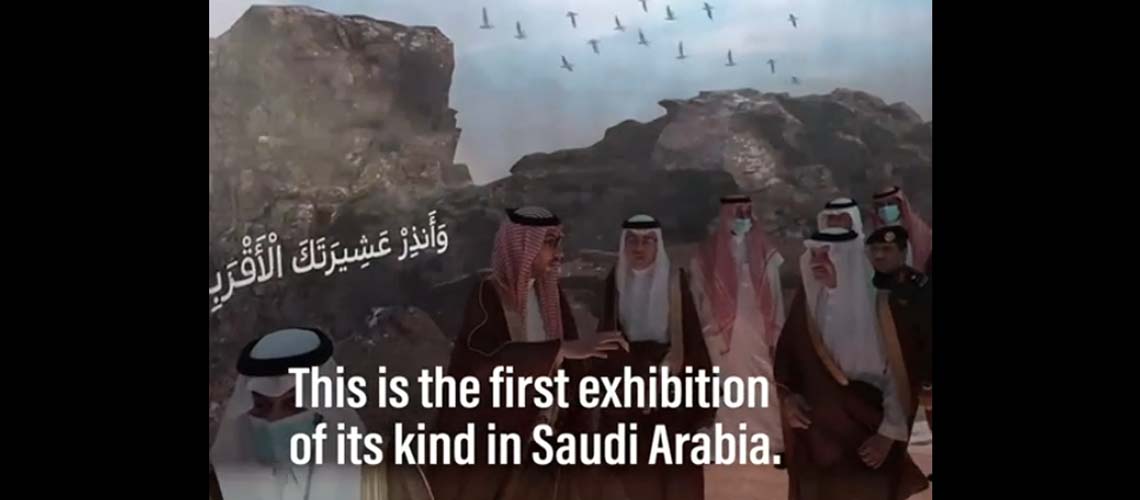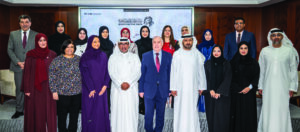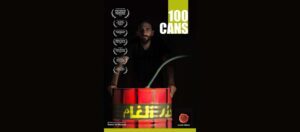Hijrah is the most important historical event that shaped the beginning of Islam and a first-of-its-kind exhibition to celebrate this, titled Hijrah Exhibition: In the Footsteps of the Prophet, opened this weekend as the region marked Hijri or Islamic new year.
The exhibition showcases the Prophet Mohammed’s migration from Makkah to Madinah over eight days and 400 kilometres.
The show was curated by Abdullah Hussein Alkadi, a leading Hijrah scholar and biographer of the Prophet Mohammed, along with international partners and artists. It showcases numerous artefacts in collaboration with the National Museum of Saudi Arabia, the House of Islamic Arts, the King Abdulaziz Complex for Waqf Libraries and The Prince of Wales’ charity Turquoise Mountain.
“My own life has been determined by my quest to study and experience not only the exact route the Prophet and his companions took across the desert but also the wider story, life and legacy of this journey,” says Alkadi.
“It has been a journey that has occupied me for some 40 years and, with this exhibition, we are presenting new research, methodologies and findings based on extensive fieldwork that will redefine perspectives on this historic migration. The relevance of this story is just as strong today; it serves to demonstrate and remind us of the reasons people choose to move from one place to another and asserts the right to practice your beliefs.”
An immersive experience
The exhibition looks at the history and legacy of Hijrah from different perspectives, including those of science, physical geography, material culture, theology, art and cultural memory.
Scholars and artists help to narrate and depict the journey through immersive audiovisual works, using text, light, art, theatrical performances and film with academic research and storytelling.
Several collective works have been created by commissioned regional and international artists and numerous documentaries and books are on display that tell the story of Hijrah.
:quality(70)/cloudfront-eu-central-1.images.arcpublishing.com/thenational/KFABAVXKWJGDJGCKZJ7QW733QM.jpeg)
Saudi artist Zahrah Al Ghamdi is showcasing her artwork at the exhibition, for example, and she’s used natural materials such as earth, clay, rocks, leather and water to create knot-like structures reflecting “brotherhood ties” that were forged when people came together in Madinah during Hijrah.
“As one of the most detailed studies ever of the history and topography of the Hijrah, this exhibition exemplifies Ithra’s wider mission to tell the world’s defining stories through art, heritage, culture and research,” says Ithra director Abdullah Al-Rashid.
“This exhibition represents significant advances in academic research around the history of Islam, while its focus on the human story surrounding the journey and our shared human values will also promote greater understanding, empathy and tolerance.”
:quality(70)/cloudfront-eu-central-1.images.arcpublishing.com/thenational/X23IFFZR5RG4FIFU3NMNVELPWQ.jpeg)
Ovidio Salazar, an award-winning director from California, will also be revealing a documentary at Ithra in December. Salazar, who has worked on various Islamic films, was approached by Ithra two years ago to work on a documentary and travelled along the path of Hijra to document the significant journey.
“The theme of migration and refugees is still relevant today, which makes the topic interesting to not just regional but international audiences,” he tells The National. “But the vision was bigger” for the exhibition, he says, and he hopes “its rich and immersive nature” engages audiences from across the world.
What is Hijrah?
Hijrah, meaning migration, is a seminal point in Islamic history. It occurred in the year 622, when the Prophet Mohammed and his companion Abu Bakr fled Makkah to Madinah (then Yathrib) upon invitation by the city’s leaders and to escape persecution by Makkah’s ruling Quraysh tribe.
Fearing for their lives, more Muslims eventually made the similar journey and, as a result, the first Muslim society was born. Madinah also became the stage from which the Prophet Mohammed and followers would return to conquer Makkah in 629.
:quality(70)/cloudfront-eu-central-1.images.arcpublishing.com/thenational/DOMHQH443RFTPIMAKVP4TMPIAY.jpeg)
“The learning here is the unity we want in the world,” Farah Abushullaih, head of Ithra museum, tells The National.
In the exhibition, which was conceived more than three years ago, you see a blend of cultures and contributions, from contemporary art to artefacts incorporated that make “it extremely unique and relative to all”, says Abushullaih.
The universality of the concept was extremely crucial to Ithra, she explains, and says that the important topic was to be handled with extreme sensitivity. “You have to ensure you have the collective consensus of the experts, of those who have studied this for years, who endorsed the content we have and making sure the masses are happy with the story you’re telling,” she says.
The beauty of the exhibition, says Abushullaih, is in the “magical” way it’s curated, “the untold stories, the journey’s chronological order, and the way it ties up at the end”.
The future of the exhibition
Hijrah will run for nine months at Ithra. The exhibition will be showcased around the kingdom, the region and the world over a period of five years, according to Ithra officials.
Hijrah exhibition at Ithra follows Prophet Mohammed’s migration from Makkah to Madinah
www.thenationalnews.com




